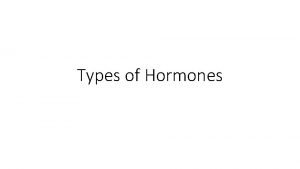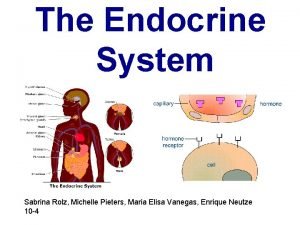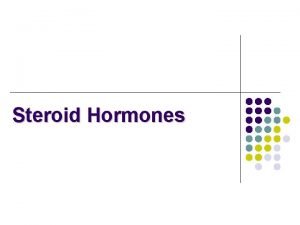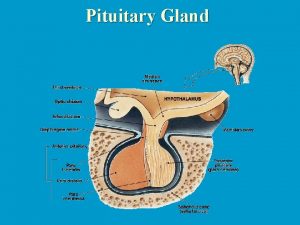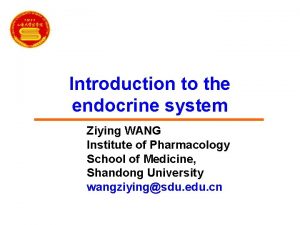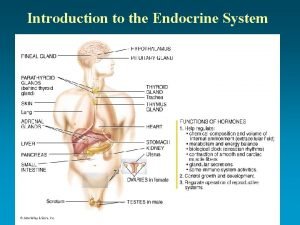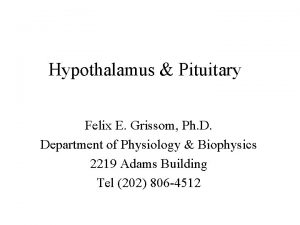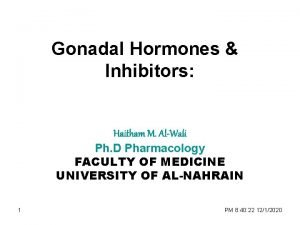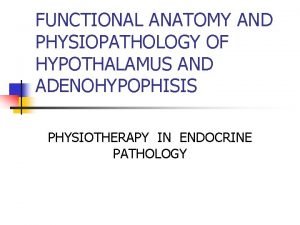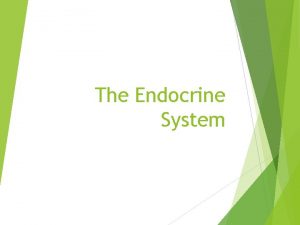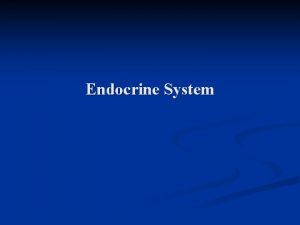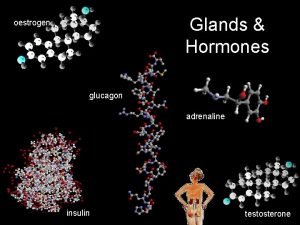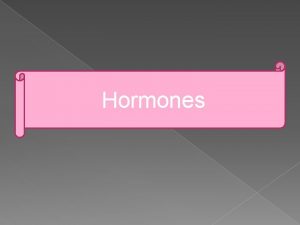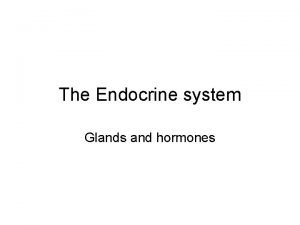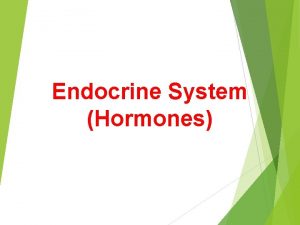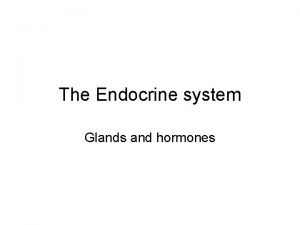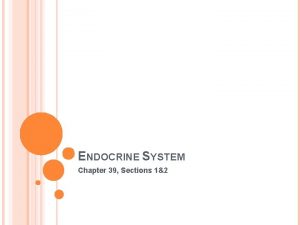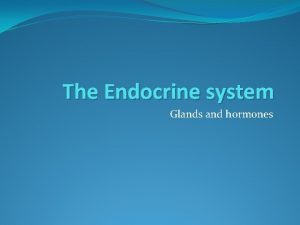How Do Endocrine Hormones Work Like oestrogen are















- Slides: 15

How Do Endocrine Hormones Work?

• Like oestrogen are messenger molecules that are secreted by endocrine glands into the bloodstream. • They travel throughout the body in the circulation. • Although they reach virtually every cell in the body in this way, each hormone affects only certain cells, called target cells. Endocrine hormones • A target cell is the type of cell on which a hormone has an effect. A target cell is affected by a particular hormone because it has receptor proteins — either on the cell surface or within the cell — that are specific to that hormone. • An endocrine hormone travels through the bloodstream until it finds a target cell with a matching receptor to which it can bind. • When the hormone binds to the receptor, it causes changes within the cell. The manner in which it changes the cell depends on whether the hormone is a steroid hormone or a non-steroid hormone.

• A steroid hormone such as oestrogen is made of lipids. • It is fat soluble, so it can diffuse across a target cell’s plasma membrane, which is also made of lipids. • Once inside the cell, a steroid hormone binds with receptor proteins in the cytoplasm. Steroid Hormones • As you can see in the diagram next slide, the steroid hormone and its receptor form a complex, called a steroid complex, which moves into the nucleus where it influences the expression of genes. • Examples of steroid hormones include cortisol, which is secreted by the adrenal glands, and sex hormones, which are secreted by the gonads.

Steroid Hormones Figure 12. 3. 2 : A steroid hormone crosses the plasma membrane of a target cell, binds with a receptor protein within the cytoplasm, and forms a complex that moves to the nucleus where it affects gene expression. (public domain; Ladyof. Hats; CK-12 Foundation)

• A non-steroid hormone is made of amino acids. Non-steroid Hormones • It is not fat soluble, so it cannot diffuse across the plasma membrane of a target cell. Instead, it binds to a receptor protein on the cell membrane. In the following diagram next slide, you can see that the binding of the hormone with the receptor activates an enzyme in the cell membrane. • The enzyme then stimulates another molecule, called the second messenger, which influences processes inside the cell. • Most endocrine hormones are non-steroid hormones. • Examples include glucagon and insulin, both produced by the pancreas.

Non-steroid Hormones Figure 12. 3. 3 : A non-steroid hormone binds with a receptor protein on the plasma membrane of a target cell. This activates an enzyme, which controls a secondary messenger molecule. (public domain; Ladyof. Hats; CK-12 Foundation)

Regulation of Endocrine Hormones • Endocrine hormones regulate many body processes, but what regulates the secretion of endocrine hormones? Most endocrine hormones are controlled by feedback mechanisms. A feedback mechanism is a loop in which a product feeds back to control its own production. Feedback loops may be either negative or positive. • Most endocrine hormones are regulated by negative feedback loops. Negative feedback keeps the concentration of a hormone within a relatively narrow range and maintains homeostasis. • Very few endocrine hormones are regulated by positive feedback loops. Positive feedback causes the concentration of a hormone to become increasingly higher.

• A negative feedback loop controls the synthesis and secretion of hormones by the thyroid gland. • This loop includes the hypothalamus and pituitary gland in addition to the thyroid, as shown in the diagram next slide. • When the levels of thyroid hormones circulating in the blood fall too low, the hypothalamus secretes thyrotropin releasing hormone (TRH). Regulation by Negative Feedback • This hormone travels directly to the pituitary gland through the thin stalk connecting the two structures. • In the pituitary gland, TRH stimulates the pituitary to secrete thyroid stimulating hormone (TSH). TSH, in turn, travels through the bloodstream to the thyroid gland stimulates it to secrete thyroid hormones. • This continues until the blood levels of thyroid hormones are high enough. At that point, the thyroid hormones feed back to stop the hypothalamus from secreting TRH and the pituitary from secreting TSH. • Without the stimulation of TSH, the thyroid gland stops secreting its hormones. • Eventually, the levels of thyroid hormones in the blood start to fall too low again. When that happens, the hypothalamus releases TRH, and the loop repeats.

Regulation by Negative Feedback Figure 12. 3. 4 : This diagram shows how the thyroid gland is regulated by a negative feedback loop that also involves the hypothalamus and pituitary gland. (public domain; Rupali Raju; CK-12 Foundation)

• Prolactin is a non-steroid endocrine hormone secreted by the pituitary gland. One of the functions of prolactin is to stimulate a nursing mother’s mammary glands to produce milk. Regulation by Positive Feedback • The regulation of prolactin in the mother is controlled by a positive feedback loop that involves the nipples, hypothalamus, pituitary gland, and mammary glands. • Positive feedback begins when a baby suckles on the mother’s nipple. Nerve impulses from the nipple reach the hypothalamus, which stimulates the pituitary gland to secrete prolactin. • Prolactin travels in the blood to the mammary glands and stimulates them to produce milk. The release of milk causes the baby to continue suckling, which causes more prolactin to be secreted and more milk to be produced. • The positive feedback loop continues until the baby stops suckling at the breast.

Feature: Myth vs. Reality • Anabolic steroids are synthetic versions of the naturally occurring male sex hormone testosterone. • Male hormones have androgenic, or masculinizing, effects, but they also have anabolic, or muscle-building effects. • The anabolic effects are the reason that synthetic steroids are used by athletes. In addition to building muscles, they also accelerate the development of bones and red blood cells, increase endurance so athletes can train harder and longer, and speed up muscle recovery. • Unfortunately, these benefits of steroid use come with costs. If you ever consider taking anabolic steroids to build muscles and improve athletic performance, consider the following myths and corresponding realities.

• Myth: Steroids are safe. Feature: Myth vs. Reality cont. • Reality: Steroid use may cause several serious side effects. Prolonged use may increase the risk of liver cancer, heart disease, and high blood pressure. • Myth: Steroids will not stunt your growth. • Reality: Teens who take steroids before they have finished growing in height may have their growth stunted so they remain shorter throughout life than they would otherwise have been. Such stunting occurs because steroids increase the rate at which skeletal maturity is reached. Once skeletal maturity occurs, additional growth in height is impossible.

• Myth: Steroids do not cause drug dependency. • Reality: Steroid use may cause dependency as evidenced by the negative effects of stopping steroid use. These negative effects may include insomnia, fatigue, and depressed mood, among others. Feature: Myth vs. Reality cont. • Myth: There is no such thing as “roid rage. ” • Reality: Steroid use has been shown to increase aggressiveness in some people. It has also been implicated in a number of violent acts committed by people who had not demonstrated violent tendencies until they started using steroids. • Myth: Only males use steroids. • Reality: Although steroid use is more common in males than females, some females also use steroids. They use them to build muscle and improve physical performance, generally either for athletic competition or for self-defence.

• Endocrine hormones are messenger molecules that are secreted by endocrine glands into the bloodstream. They travel throughout the body but affect only certain cells, called target cells, which have receptors specific to particular hormones. • Steroid hormones such as oestrogen are endocrine hormones made of lipids that cross plasma membranes and bind to receptors inside target cells. The hormone-receptor complexes then move into the nucleus where they influence gene expression. Summary • Non-steroid hormones such as insulin are endocrine hormones made of amino acids that bind to receptors on the surface of target cells. This activates an enzyme in the plasma membrane, and the enzyme controls a second messenger molecule, which influences cell processes. • Most endocrine hormones are controlled by negative feedback loops in which rising levels of a hormone feed back to stop its own production — and vice-versa. For example, a negative feedback loop controls production of thyroid hormones. The loop includes the hypothalamus, pituitary gland, and thyroid gland. • Only a few endocrine hormones are controlled by positive feedback loops in which rising levels of a hormone feed back to stimulate continued production of the hormone. Prolactin, the pituitary hormone that stimulates milk production by mammary glands, is controlled by a positive feedback loop. The loop includes the nipples, hypothalamus, pituitary gland, and mammary glands.

The End
 Mikael ferm
Mikael ferm Chapter 45 hormones and the endocrine system
Chapter 45 hormones and the endocrine system Nontropic hormones
Nontropic hormones Steroid hormone lipid
Steroid hormone lipid Amino acid derivative hormones
Amino acid derivative hormones Steroid hormones classification
Steroid hormones classification Plant biology ppt
Plant biology ppt Hormones secreted by adenohypophysis
Hormones secreted by adenohypophysis Hipofisis gland
Hipofisis gland Amine hormone
Amine hormone Lipid soluble hormones examples
Lipid soluble hormones examples Hypothalamus hormones
Hypothalamus hormones Lipid soluble hormones examples
Lipid soluble hormones examples Lipid soluble hormones examples
Lipid soluble hormones examples Gonadal hormones
Gonadal hormones Abreviation
Abreviation



